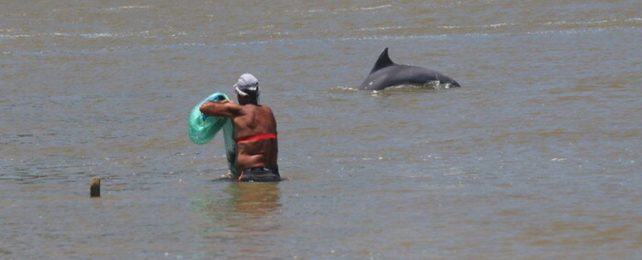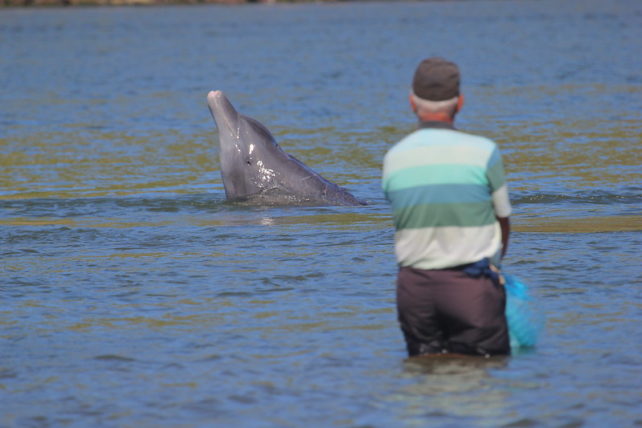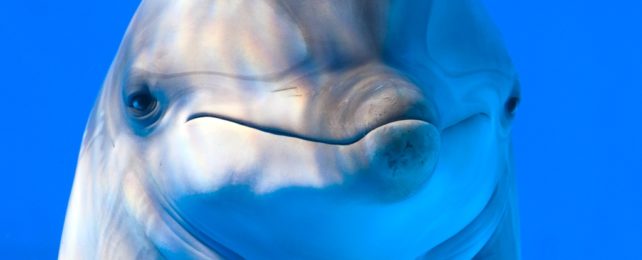Humans and dolphins on the southern coast of Brazil have created a carefully synchronized 'dance' to shepherd as much migrating mullet into their nets and mouths as possible.
Traditional fishers in the city of Laguna have been working with Lahille's bottlenose dolphins (Tursiops truncatus gephyreus) to capture fish for more than 140 years.
From above, the dolphins appear to drive schools of mullet into the shore, right near fishers who are wading in the shallows. Only after receiving a cue from the dolphins do the fishers throw their nets.

Researchers have spent more than a decade studying this close relationship, and they say it is a rare example of mutualism, in which two species help each other to both improve their chances of survival.
"We knew that the fishers were observing the dolphins' behavior to determine when to cast their nets, but we didn't know if the dolphins were actively coordinating their behavior with the fishers," says marine biologist Mauricio Cantor of Oregon State University.
"Using drones and underwater imaging, we could observe the behaviors of fishers and dolphins with unprecedented detail and found that they catch more fish by working in synchrony."
The fight to survive in nature is often portrayed as just that: a battle for limited resources, mates, or territories. But cooperation is also an important part of the equation that tends to get overlooked.
Teamwork and synchronized activity within a species is common – think of fish swimming in a school or lions hunting in packs – but two different animal species working together is far more rare.
Humans have always interacted with wildlife for our own gain. Our ancestors took wild wolves and turned them into domesticated dogs for hunting and protection. They also welcomed cats into the fold. But more often than not in cases of interspecies interactions, only one animal is benefiting, like sharks that feed on the scraps left behind by fishers.
It's more unusual to find a mutually beneficial relationship, but even when two species are after the same prey, lunch doesn't have to be a zero sum game.
Cooperative fishing between humans and cetaceans – aquatic mammals such as dolphins and whales – is a great example of just that.
In the past, human whalers have teamed up with orcas to hunt baleen whales in southeastern Australia. Meanwhile, in Eastern Australia, eyewitness accounts and stories from Aboriginal Australians suggest that dolphins and humans once fished alongside one another more frequently than they do today.
The traditional fishers of Laguna in Brazil are some of the only examples left of such a close and cooperative bond.
Both the dolphins and the local fishers have learned to read each other's body language and respond accordingly.
Fishers, wearing GPS wristbands while wading in the shallows so their motion could be tracked, moved towards dolphins the moment the marine mammals arrived on the scene. They also cast their nets at higher rates when dolphins were around.
Clearly, the mammals were a clue that mullet were near. Fishers who followed their fins were 17 times more likely to capture fish in the shallows. They also caught 4 times as much, even if they spent the same amount of time casting their nets.
"Dolphins clearly generate foraging benefits to fishers and stimulate beneficial actions in response to increased mullet availability that is not present when dolphins are absent," the authors write.

But what do the dolphins get out of it? It's a lot harder to count how much fish a mammal swallows compared to how much a fisher catches. And how does a dolphin's catch in the presence of humans differ to its catch without humans?
Researchers have used a few clues above and below the water to find out. From above, the authors noticed dolphins approaching quite close to fishers and giving them a cue to cast their nets – a deep dive.
Beneath the water, meanwhile, dolphins increase their echolocation clicks when fishers cast their nets. When the nets are down, dolphins also dive for longer.
Researchers suspect the dolphins are benefiting from the way the nets disrupt the school of mullet and sends individuals off on their own, making them easier to snag. Underwater footage also shows individual dolphins grabbing fish straight from the nets, and local fishers report feeling this happen often.
Almost all the local fishers interviewed by researchers said they believed the marine mammals were gaining extra fish in the situation.
In the end, the authors calculate that bottlenose dolphins who engage in cooperative fishing are 13 percent more likely to survive.
But if anything were to happen to the dolphins, the mullet, or the humans in this area, those benefits could disappear. There's nothing genetically different about these mammals. This behavior is all about context, and there's no saying how long that context will last.
"Safeguarding cultural behaviors that benefit both humans and wildlife not only encourages their coexistence but is also emblematic of how the conservation of 'culturally significant units' advances the conservation of biodiversity," the authors write.
Mutualism between humans and wildlife is getting more and more rare, Cantor says. It's important we preserve it where we can.
The study was published in PNAS.
